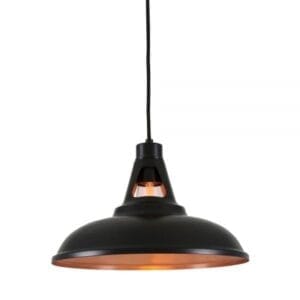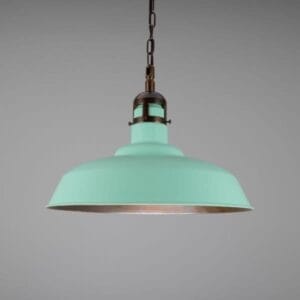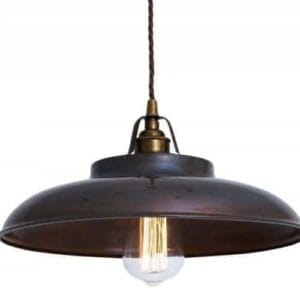Dome Kitchen Pendant Lights
Classic Kitchen Lighting That Never Fails
Dome pendants are the Swiss Army knife of kitchen lighting—they work in virtually any style, suit any era of property, and manage to look both timeless and contemporary. While trends come and go, the simple elegance of a well-chosen dome pendant remains consistently popular for good reason.
If you’re planning kitchen lighting and want something that’ll still look right in ten years, dome pendants deserve serious consideration.
- Dome Kitchen Pendant Lights
- Classic Kitchen Lighting That Never Fails
- Why Dome Pendants Work Everywhere
- Size Matters: Getting Your Dome Proportions Right
- Colour and Finish: Making Your Choice
- Material Choices That Matter
- Dome Pendants vs Cage Pendants: Which Suits You?
- Getting the Practical Details Right
- Creating Impact with Multiple Pendants
- Coordinating Your Kitchen Lighting
- Making Your Final Decision: Quick Guide
- Ready to Find Your Perfect Dome Pendant?
Why Dome Pendants Work Everywhere
The Shape That Makes Sense
There’s a reason dome shapes appear in architecture from ancient Rome to modern Scandinavia—they’re inherently pleasing to the eye. That gentle curve directs light downward efficiently whilst the enclosed shade prevents glare, making dome pendants as functional as they are attractive.
Unlike open or geometric designs that can feel stylistically specific, domes have a universal quality that transcends trends.
Light Distribution Done Right
The dome shape naturally focuses light where you need it—downward onto your workspace—whilst the interior reflective surface maximizes efficiency. You get excellent task lighting without harsh shadows or bright spots.
Most dome pendants also allow some light to escape upward and around the rim, providing gentle ambient lighting that prevents the fixture from creating a spotlight effect. This balance makes them perfect for kitchen islands where you’re both working and socializing.
Style Chameleons
Dome pendants adapt to their surroundings remarkably well:
- Traditional kitchens – Classic enamel or ceramic domes complement Shaker cabinetry beautifully
- Contemporary spaces – Sleek metal domes in chrome or brushed steel suit modern units perfectly
- Country kitchens – Coloured enamel or aged metal finishes add character without overwhelming rustic elements
- Scandi-style – Simple white or grey domes embody minimalist Nordic design principles
- Industrial schemes – Weathered or factory-style domes provide authentic period character
The same basic shape works across all these styles—you’re just choosing different materials and finishes.
Size Matters: Getting Your Dome Proportions Right
The most common mistake with dome pendants? Choosing fixtures that are too small for the space. A dome that looks substantial in a showroom can disappear over a large kitchen island.
Small Domes (20-25cm diameter)
Best for:
- Breakfast bars or compact islands (up to 1.2m)
- Clustering in groups of three or more
- Smaller kitchens where large fixtures overwhelm
- Accent lighting rather than primary illumination
Small domes work brilliantly in multiples—three 20cm domes often create better impact than one 30cm dome.
Medium Domes (28-35cm diameter)
Best for:
- Standard kitchen islands (1.5-2.5m)
- Used in pairs or threes
- Most residential kitchens
- Balancing substantial presence with practical scale
This is the sweet spot for most homes—large enough to make a statement, practical enough for everyday use.
Part of The Dome Collection
Large Domes (40cm+ diameter)
Best for:
- Substantial islands in large kitchens
- High ceilings (2.7m+)
- Making bold statements
- Commercial-style kitchens
Large domes command attention and work beautifully in spacious, open-plan areas where smaller fixtures would look lost.
The Two-or-Three Rule
For kitchen islands, two or three pendants almost always look better than one. The rhythm created by multiple fixtures adds visual interest and provides more even light distribution.
Islands up to 2m: Two medium domes Islands 2-3m: Three medium domes or two large domes Islands 3m+: Three large domes or five smaller domes
Space them 75-90cm apart and hang 75-85cm above the worktop for optimal lighting and proportions.
Colour and Finish: Making Your Choice
Classic White and Cream
White enamel domes are the failsafe choice—they work with everything and never look dated. They brighten kitchens by reflecting light upward and suit both traditional and contemporary schemes.
Ideal for:
- All-white or predominantly light kitchens
- Scandi-inspired schemes
- Period properties where you want sympathetic modern additions
- Creating a fresh, clean aesthetic
Bold Colours
Coloured enamel domes—particularly heritage shades like racing green, slate blue, or burgundy—add personality without the commitment of coloured units.
Ideal for:
- Injecting character into neutral kitchens
- Coordinating with existing accent colours
- Country or farmhouse kitchens wanting warmth
- Making a statement without overwhelming the space
Navy blue domes against white units create stunning contrast. Forest green complements wooden elements beautifully. Even bold reds can work in the right context, adding energy and warmth.
Metallic Finishes
Brushed steel, polished chrome, antique brass, or copper domes bring metallic warmth and coordinate with taps, handles, and appliances.
Ideal for:
- Modern kitchens with stainless appliances
- Creating cohesion with other metallic elements
- Adding warmth (brass/copper) or cool sophistication (chrome/steel)
- Industrial-influenced schemes wanting a refined edge
Aged and Weathered
Vintage-effect finishes—distressed enamel, aged brass, or weathered metal—add instant character and a sense of history.
Ideal for:
- Period properties
- Farmhouse or cottage kitchens
- Creating lived-in character in new builds
- Softening overly modern spaces
Material Choices That Matter
Enamel Domes
Traditional vitreous enamel over steel creates that classic factory pendant look. The smooth, glossy finish is easy to clean and highly durable—there’s a reason these fixtures lasted decades in their original industrial settings.
Quality enamel pendants have proper weight to them and smooth, consistent coating. Cheap versions chip easily and show manufacturing flaws.
Metal Domes
Spun metal—usually steel or aluminum—can be left natural, painted, or powder-coated. Metal domes tend to have a slightly more industrial edge than enamel, even in similar shapes.
Brushed or hammered finishes add texture and hide fingerprints better than polished surfaces—worth considering for busy kitchens.
Glass Domes
Less common but beautiful when done well. Glass domes, particularly in opal or frosted finishes, create softer, more diffused light. They suit more decorative schemes where the pendant is as much about ambiance as task lighting.
Clear glass domes showcase decorative bulbs, combining the dome’s structured shape with the interest of visible filaments.
Dome Pendants vs Cage Pendants: Which Suits You?
Both styles have devoted followers, and the choice often comes down to the aesthetic you’re creating.
Choose Dome Pendants If:
- You want a softer, more refined look
- Your kitchen leans traditional or classic contemporary
- You prefer enclosed shades for cleaner lines
- You want minimal visual clutter
- You’re after timeless design that won’t date
Choose Cage Pendants If:
- You love industrial or utilitarian design
- You want maximum light output in all directions
- You appreciate visible structure and honest materials
- Your style leans modern industrial or eclectic
- You want fixtures with more visual texture
The good news? You don’t have to choose. Many successful kitchens use dome pendants over the island and cage wall lights elsewhere, or vice versa. The two styles complement each other beautifully.
Getting the Practical Details Right
Installation Height
The standard 75-85cm above your worktop works for most situations, but adjust based on:
- Your height – Taller people need slightly higher fixtures
- Ceiling height – Higher ceilings can accommodate lower pendants
- Island use – Dining islands need higher mounting to avoid lights in eye-lines
Bulb Selection
Dome pendants work with virtually any bulb type, giving you flexibility:
LED filament bulbs add decorative interest whilst being energy-efficient. In clear glass or lighter-coloured domes, the visible filament becomes part of the design.
Standard LED bulbs maximize brightness and efficiency. Choose warm white (3000K) for a flattering, welcoming glow.
Dimmable options are essential. You want bright task lighting for cooking and softer ambient light for entertaining.
Cable Length
Many dome pendants come with adjustable cables, letting you set the perfect drop. If your pendant has fixed cable length, check it’ll work with your ceiling height before ordering.
For sloped ceilings, look for pendants designed for angled mounting—not all are.
Creating Impact with Multiple Pendants
While a single dome pendant can work, multiples create far more visual interest and better light distribution.
Linear Arrangements
The classic approach—pendants spaced evenly along your island’s length. This creates rhythm and balance whilst providing consistent illumination.
Keep spacing between 75-90cm for the best visual effect.
Varied Heights
Stagger your pendants at slightly different heights (10-15cm variation) for a more dynamic, contemporary look. This works particularly well with three or five pendants.
Clustered Arrangements
For wider islands or dining areas, consider clustering three smaller domes at one end rather than spacing them evenly. This creates a focal point whilst leaving other areas more open.
Mixing Sizes
Using different sizes—perhaps two medium and one large—adds visual interest whilst maintaining family resemblance. This works best with identical finishes so the size variation reads as intentional design rather than mismatched fixtures.
Coordinating Your Kitchen Lighting
Dome pendants should be part of a layered lighting scheme, not working alone:
Ambient lighting – Ceiling downlights provide overall illumination Task lighting – Your dome pendants over the island, plus under-cabinet lighting for worktops Accent lighting – Optional wall lights or plinth lighting for atmosphere
Consider matching dome wall lights to echo your pendant choice and create cohesion throughout the space.
Making Your Final Decision: Quick Guide
Choose dome pendants if:
- ✓ You want timeless, versatile design
- ✓ You prefer refined elegance over industrial edge
- ✓ You need excellent focused task lighting
- ✓ You want fixtures that suit multiple kitchen styles
- ✓ You appreciate clean, uncluttered aesthetics
Consider alternatives if:
- ✗ You strongly prefer open, structural fixtures
- ✗ Your scheme is heavily industrial and needs edgier lighting
- ✗ You want maximum light spread in all directions
Ready to Find Your Perfect Dome Pendant?
Dome pendants offer that rare combination of practical excellence and timeless style. They work hard, look great, and adapt to virtually any kitchen scheme—which explains why they’ve remained popular for over a century.
Browse our complete range of pendant lights and discover dome designs that’ll suit your kitchen perfectly. From classic enamel to contemporary metal finishes, we stock fixtures that work in real homes, not just design magazines.
Not sure which size, colour, or configuration suits your space? Get in touch and we’ll help you choose fixtures that’ll look fantastic for years to come. We’ve helped countless homeowners create beautifully lit kitchens—we know what works.
Want something with more industrial character? Our cage pendant lights offer similar versatility with edgier aesthetics—perfect if you want structure and texture in your lighting design.
All our pendants are manufactured to exacting UK and Irish standards with proper safety certifications. When you choose from Fisherman’s Lights, you’re investing in quality that lasts.
Transform your kitchen island with lighting that’s as practical as it is beautiful.








